The Ultimate Guide to Kindle Storage: 8 GB vs. 16 GB vs. 32 GB
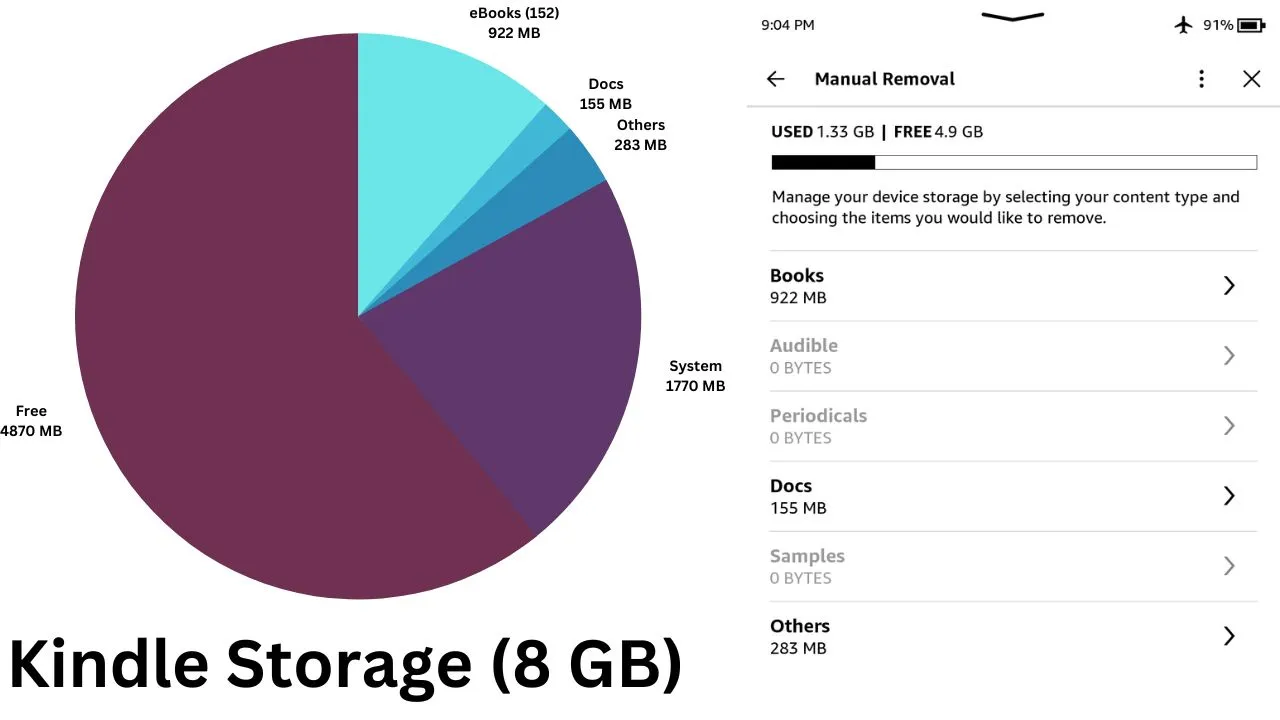
If you’re a Kindle owner or considering getting one, you’ve come to the right place. In this comprehensive guide, I’ll cut straight to the chase, giving you all the essential information you need to make informed decisions about Kindle storage. From how to check your device’s storage space to determine how many books, audiobooks, or comics it can hold, I’ve got you covered.
What Type Of Content Can You Store On A Kindle?
A Kindle device can store various types of digital content. Here’s a list of content that you can keep on a Kindle:
- eBooks (EPUB )
- Audiobooks *
- Comics
- Graphic Novels
- Microsoft Word Document: .docx or .doc
- PDF Books
- Plain Text: .txt
- Rich Text: .rtf
- HyperText Markup Language: .html, .htm
NOTE: Sideloading audiobooks is not supported on Kindles. Audible files can only be played on Kindles if downloaded directly from Amazon; this functionality is available in supported countries like the UK and the US.
How Much Space Does An E-book Take Up On Kindle?
E-books are the primary content that Kindle owners store on their devices. The amount of space an e-book occupies depends on various factors, including its length, formatting, and the inclusion of multimedia elements like images.
E-book files are usually small, ranging from 0.1MB to 4MB on average, as they primarily consist of raw text. Most books are small compared to videos and audio. However, some special editions or books with high-quality images can be larger. For example, “The Complete 5-book Hitchhiker’s Guide to the Galaxy ‘Trilogy'” is about 5 megabytes.
Here is an image of my Kindle storage: 152 e-books took up 922 MB of storage. (I have some large books with a lot of images.)
How Much Space Do Other Kindle Documents Take Up?
Kindle devices can handle more than just e-books. Here’s a breakdown of the space requirements for different types of Kindle documents:
Audiobooks
Audiobooks require significantly more space, with file sizes ranging from 50 MB to 500MB, depending on format and other factors. Currently, I have 1.27 GB of audiobooks. That’s 6 Audiobooks of varying lengths. You’ll want to factor this into your storage considerations if you’re an audiobook enthusiast.
Magazines
Magazine files vary in size, depending on the number of pages and the inclusion of high-resolution images. Expect them to take up between 10 MB and 100 MB each.
Comics and Graphic Novels
Graphic-intensive content like comics can be quite large. A single graphic novel may consume 100 MB or more. I have a 188-page full-color comic book that is a massive 1.7 gigabytes.
Documents and PDFs
Documents and PDFs can also be stored if you use your Kindle for work or academic purposes. Depending on the content, PDF files with detailed images can be larger, ranging from 1MB to 200MB or more.

Factors to Consider When Choosing Between 8GB, 16GB, and 32 GB Kindle Device
When choosing between 8GB, 16GB, and 32GB Kindle devices, you should consider several factors to ensure that you make the right choice based on your needs and preferences. Here are some key factors to consider:
Content Storage Needs
If you plan to store a significant number of audiobooks, Magazines, Comics and Graphic Novels on your Kindle, a larger storage capacity might be more suitable. Larger storage options allow you to store more content locally on your device, which can be convenient if you prefer having access to a wide variety of media without relying on a constant internet connection.
Free Cloud Storage
Amazon provides free cloud storage for your Kindle content, including any books you purchase. This means you don’t need to pay for cloud storage; you can download your purchased books whenever required. In light of this, you can reduce the requirement for a large onboard storage capacity, as you can access your content from the cloud.
Budget Constraints
Consider your budget constraints when choosing a Kindle device. Generally, higher storage capacity comes at a higher cost. Assess whether the additional storage is worth the extra expense based on your content storage needs and how you plan to use your Kindle.
Future-Proofing
Think about how your reading habits might change over time. If you’re uncertain or plan to keep the device for several years, choosing a model with more storage can be a form of future-proofing. This ensures that your device remains suitable for your needs as your content library and reading preferences evolve.
Sideloaded Content
Consider whether you have a need to sideload documents, PDFs, or other files onto your Kindle. If you need to sideload books and documents frequently, you don’t necessarily need larger storage. You can store your documents or PDFs on your laptop or desktop storage and transfer them to your Kindle when required. This can help you manage your content without relying solely on the onboard storage capacity of the Kindle device.
How Many Books Can An 8 GB Kindle Hold?
An 8GB Kindle device typically provides approximately 6.8GB of available storage space, excluding operating systems and related software. If a typical e-book takes up anywhere from 1 to 3 megabytes (MB) of space, you can keep at least 2600 to 6800 books. This is perfect for regular readers who primarily read text-based books. If your primary use is reading novels, this capacity should serve you well.
How Many Books Can A 16 GB Kindle Hold?
With 16GB of storage, you can comfortably store around 5,000 to 16,000 standard e-books. This provides more flexibility for those who enjoy a vast library of books or prefer to have a selection of novels, magazines, and audiobooks at their disposal.
How Many Books Can A 32 GB Kindle Hold?
The 32GB model typically has around 27GB of free space. However, the exact amount of free space varies from model to model. A 32GB Kindle offers even more space, allowing you to store up to 20,000 standard e-books. This option is ideal for bibliophiles who never want to worry about running out of storage space. If you’re an extensive reader with a diverse collection, this is the choice for you.
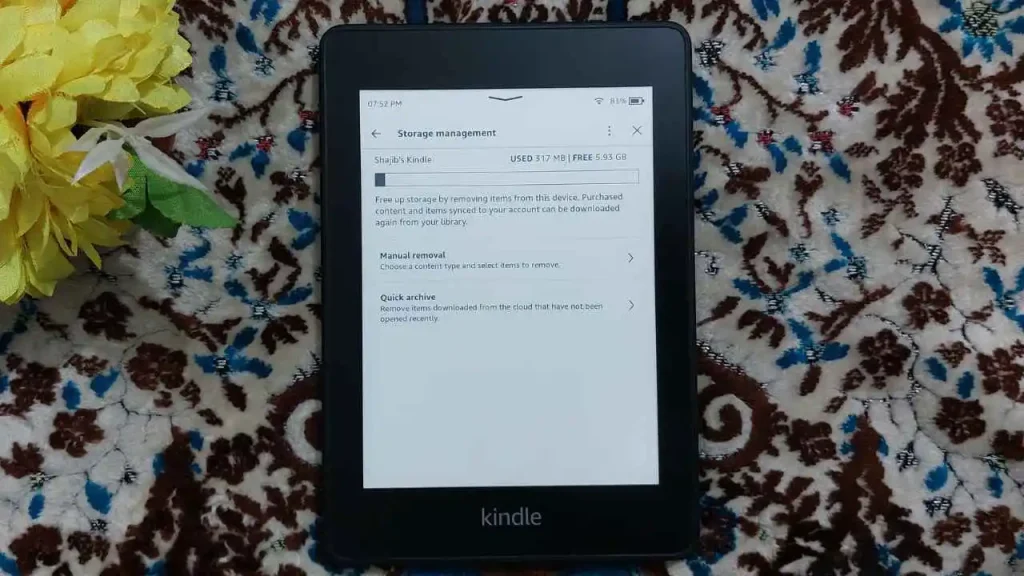
So, How Much Storage Space Is Enough For A Kindle User?
The amount of storage space you need for your Kindle primarily depends on your reading habits and the types of content you intend to store on it. Here’s a comprehensive overview of how much storage space is enough for various Kindle users.
8 GB For E-books
For most people who primarily read e-books or e-pub, 8GB of storage is generally sufficient. This includes novels, non-fiction books, and similar content. If you read e-books and occasionally download audiobooks or manga, 8GB should be enough, as long as you delete them when you’re done.
In addition, Many Kindle users delete books after reading them to save space. If you’re comfortable with this practice and don’t intend to accumulate a vast library, 8GB should suffice for most users unless you read manga or use audiobooks extensively.
16 GB Or 32 GB For Audiobooks And Manga
If you have a significant collection of audiobooks or manga and prefer to carry them on your Kindle without relying on Wi-Fi, consider a Kindle with 16GB or 32GB of storage. Audiobooks and manga can take up more space, with a full manga often requiring around 2GB. If you enjoy both formats and like the convenience of having them readily available, more storage can be beneficial.
64 GB For Heavy Users
Take into account how you use your Kindle. If you frequently switch between reading and listening to audiobooks, it might be more convenient to have them stored on the Kindle itself. In this case, devices like the 64 GB Kindle Scribe can be handy.
For PDFs And Storing Notes
If you intend to use features like storing PDFs, taking notes, and frequently downloading audiobooks, a starting point of 16GB is a good choice.
Storage Is Relatively Inexpensive
Keep in mind that storage is relatively inexpensive, and having more storage can be beneficial if you don’t like to delete books after reading them. This can also be useful if you plan to use your Kindle for other features, such as storing PDFs, taking notes, or keeping a larger library. Here is the price comparison of Kindle Scribe 16GB vs. 32GB vs. 64 GB.
| Device | Storage | Price |
|---|---|---|
| Kindle Scribe (2024 Release) | 16GB | Check Price |
| Kindle Scribe (2024 Release) | 32GB | Check Price |
| Kindle Scribe (2024 Release) | 64GB | Check Price |
Is The 8 GB Kindle Significantly Cheaper Than The 32 GB?
The 8GB Kindle is usually more budget-friendly than the 32GB version. For example, the price difference between the Kindle Paperwhite 12th gen and Kindle Paperwhite Signature Edition 12th Gen is relatively modest, especially considering the increased storage capacity you get with the 32GB model. Consider your long-term storage needs and how often you acquire new content when deciding.
Here is a price comparison of the Kindle Paperwhite 12th Gen 16GB vs. the Kindle Paperwhite Signature Edition 12th Gen 32GB.
| Device | Storage | Price |
|---|---|---|
| Kindle Paperwhite 12th Gen | 16 GB | Check Price |
| Kindle Paperwhite 12th Gen (Signature) | 32 GB | Check Price |
Is The 8 GB Kindle Suitable For Graphic Novels Or Comics?
The 8 GB Kindle may not be ideal for graphic novels or comics, especially if you plan to store a large collection of them on your device. Graphic novels and comics can have larger file sizes, with individual editions often exceeding 20 MB.
For example, 100 50 MB comics would take up 5 GB of space. However, manga and black-and-white comics tend to have smaller file sizes (around 30-50%). If you have a substantial collection of graphic novels or comics, consider opting for a Kindle with higher storage capacity, such as the 32 GB or 64 GB models.
How to check Kindle storage
Now that you know what types of content you can store on your Kindle, let’s learn how to check your device’s storage capacity. Follow these simple steps:
⇒ From your Kindle’s home screen, tap the “All Settings” option.
⇒ Next, select “Device Options” and tap “Advanced Options” to reveal more settings.
⇒ Here, you’ll find the “Storage Management” option. Tap on it to view your available storage space.
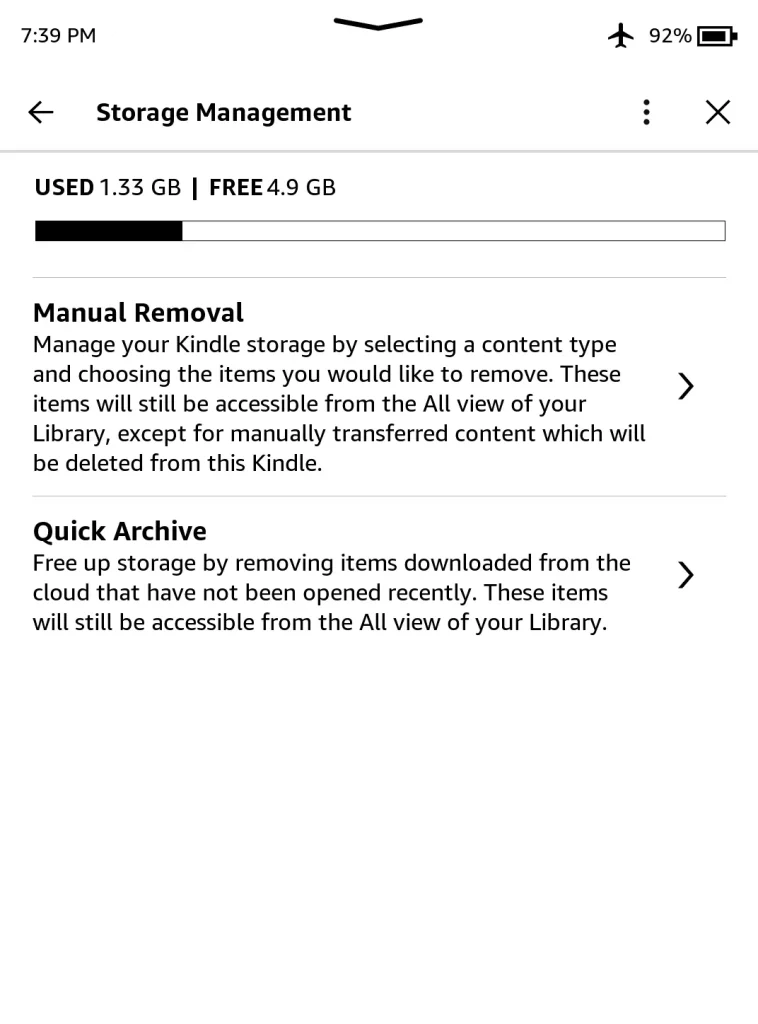
What to do when Kindle storage is full?
If you’ve maxed out your Kindle’s storage and need to add more content, you have a few options:
Delete Unused Content
As mentioned earlier, delete books or files you no longer need. Removing content that you’ve already read or no longer interests you can create ample space for new additions.
To delete books or documents, follow the steps:
Settings ⇒ Device Options ⇒ Advanced Options ⇒ Storage Management ⇒ Manual Removal ⇒ Select Books/Audible/Docs ⇒ Remove Your Content
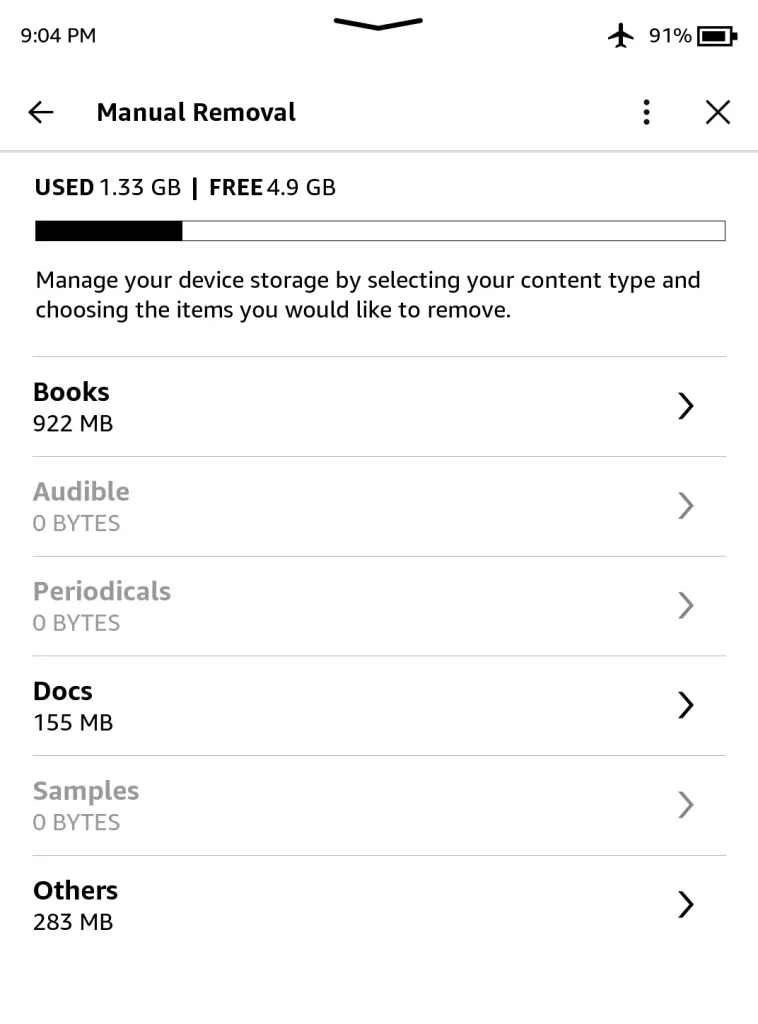
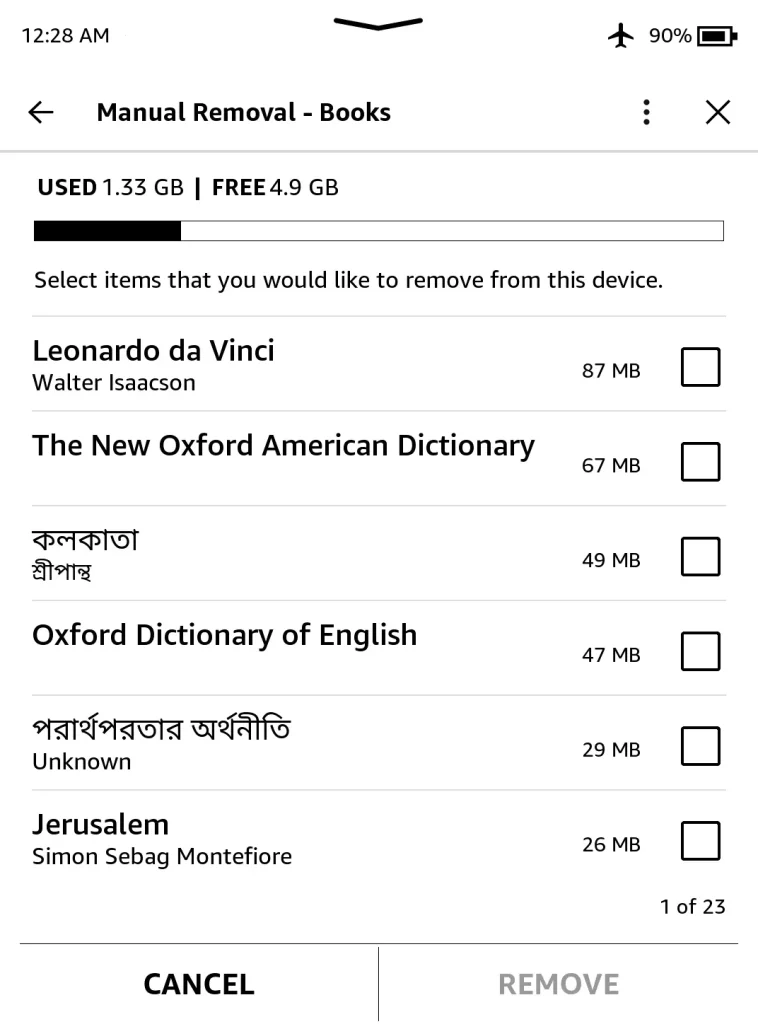
Use Cloud Storage
Utilize Amazon’s cloud storage to store some of your content remotely. This is an excellent option for books and media you don’t need immediate access but want to keep for future reading.
Archive Content
Archiving content you’ve already read but want to keep can help declutter your device. Archived items can be downloaded again at any time, making it a convenient way to manage your content.
To archive books or documents, follow the steps:
Settings ⇒ Device Options ⇒ Advanced Options ⇒ Storage Management ⇒ Quick Archive ⇒ Select 1 Month/3 Month/6 Month/1 Year or More ⇒ Tap Remove
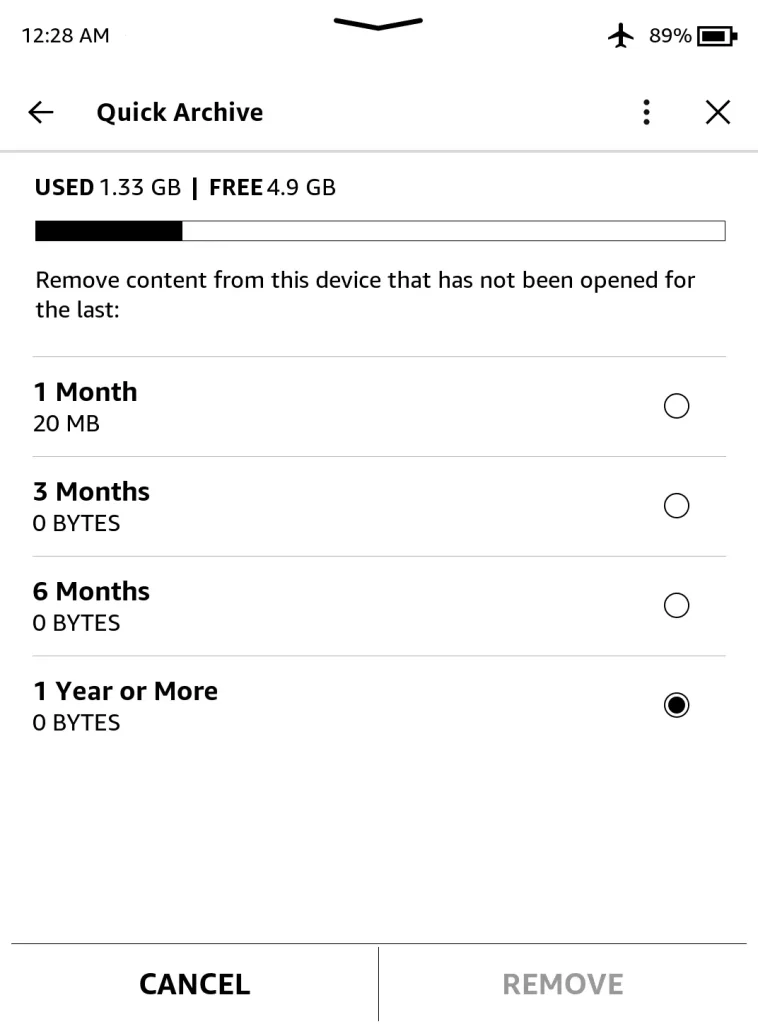
Upgrade Your Device
If you are constantly running out of space and unwilling to compromise on your digital library’s size, consider upgrading to a Kindle with a larger storage capacity. This will give you the peace of mind of never worrying about storage limitations again.
Can you expand the storage of your Kindle?
Amazon Kindle devices do not support microSD cards. The storage capacity you choose when purchasing a Kindle is fixed for the life of the device.
Final Thoughts
In summary, the ideal storage space for your Kindle depends on your specific needs and habits. 8GB is generally suitable for most readers who primarily consume e-books or e-pubs and are willing to manage their library by deleting books when necessary. However, if you have a diverse reading diet that includes audiobooks, manga, graphic novels, and comics and prefer not to delete books, opting for 16GB or 32GB may be more practical to ensure ample space for your digital library. Ultimately, your choice should align with your unique reading preferences and usage patterns.

I have a 12 gen kindle fire. I have a thousand ebooks stored. Is my content safe?